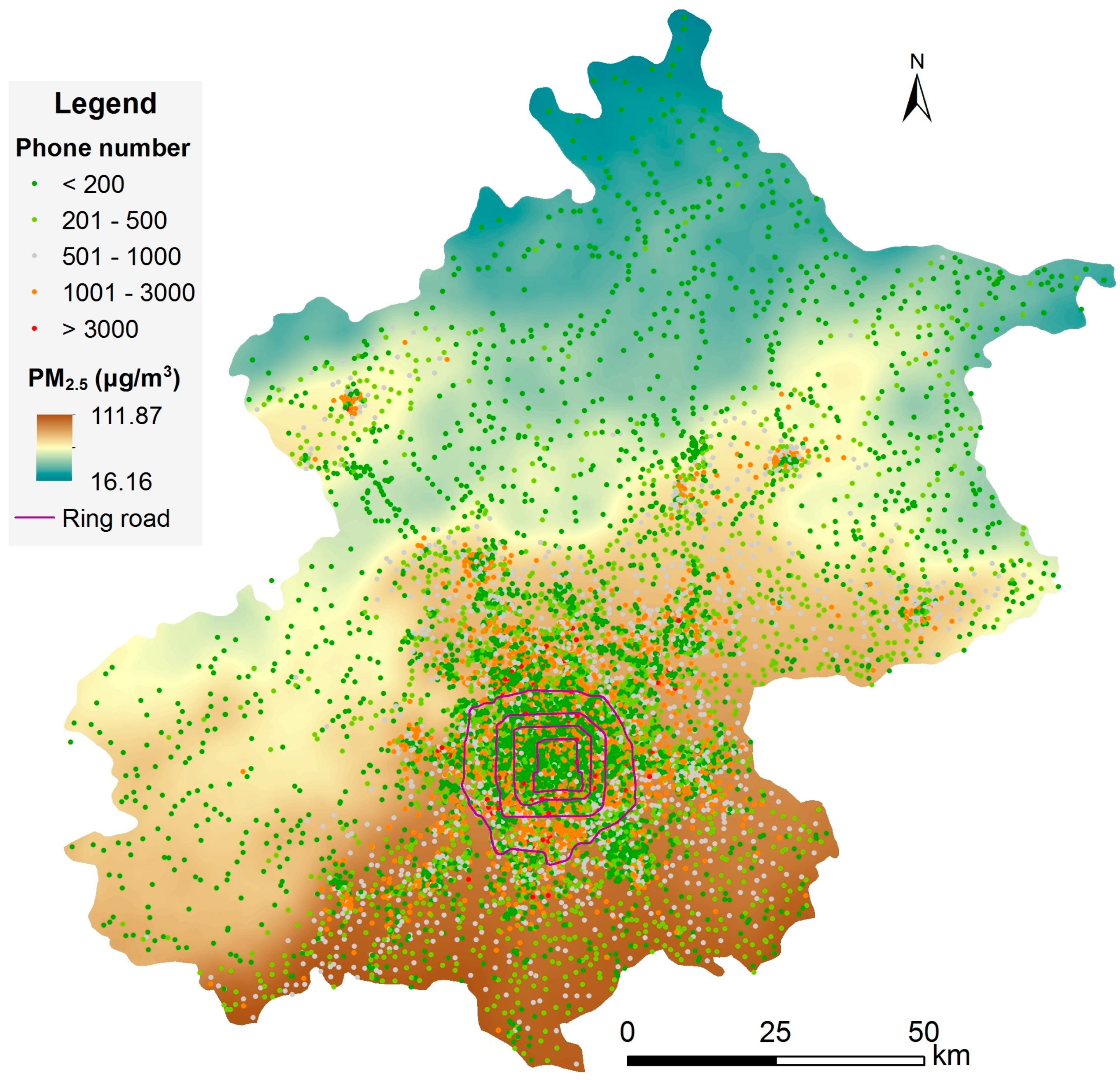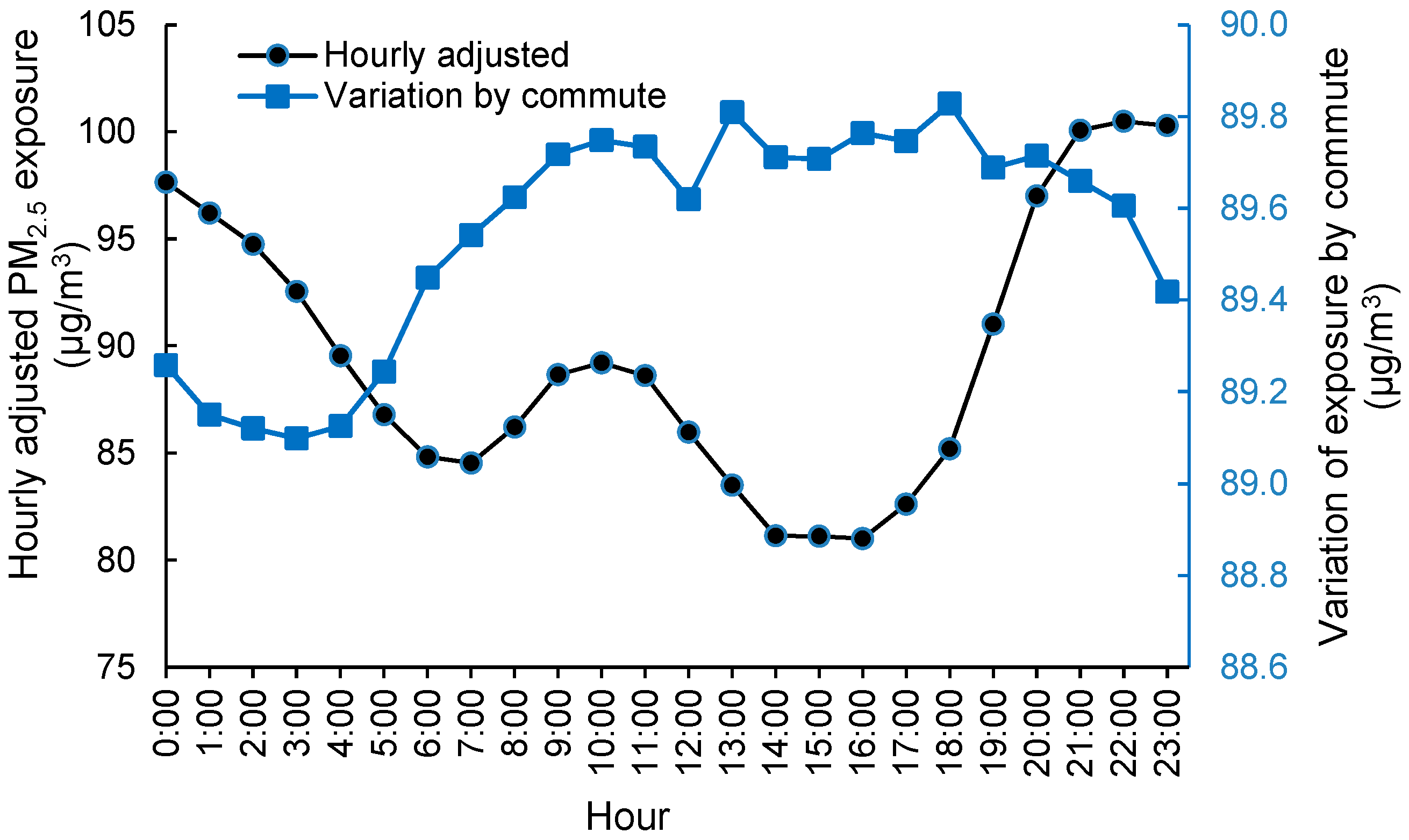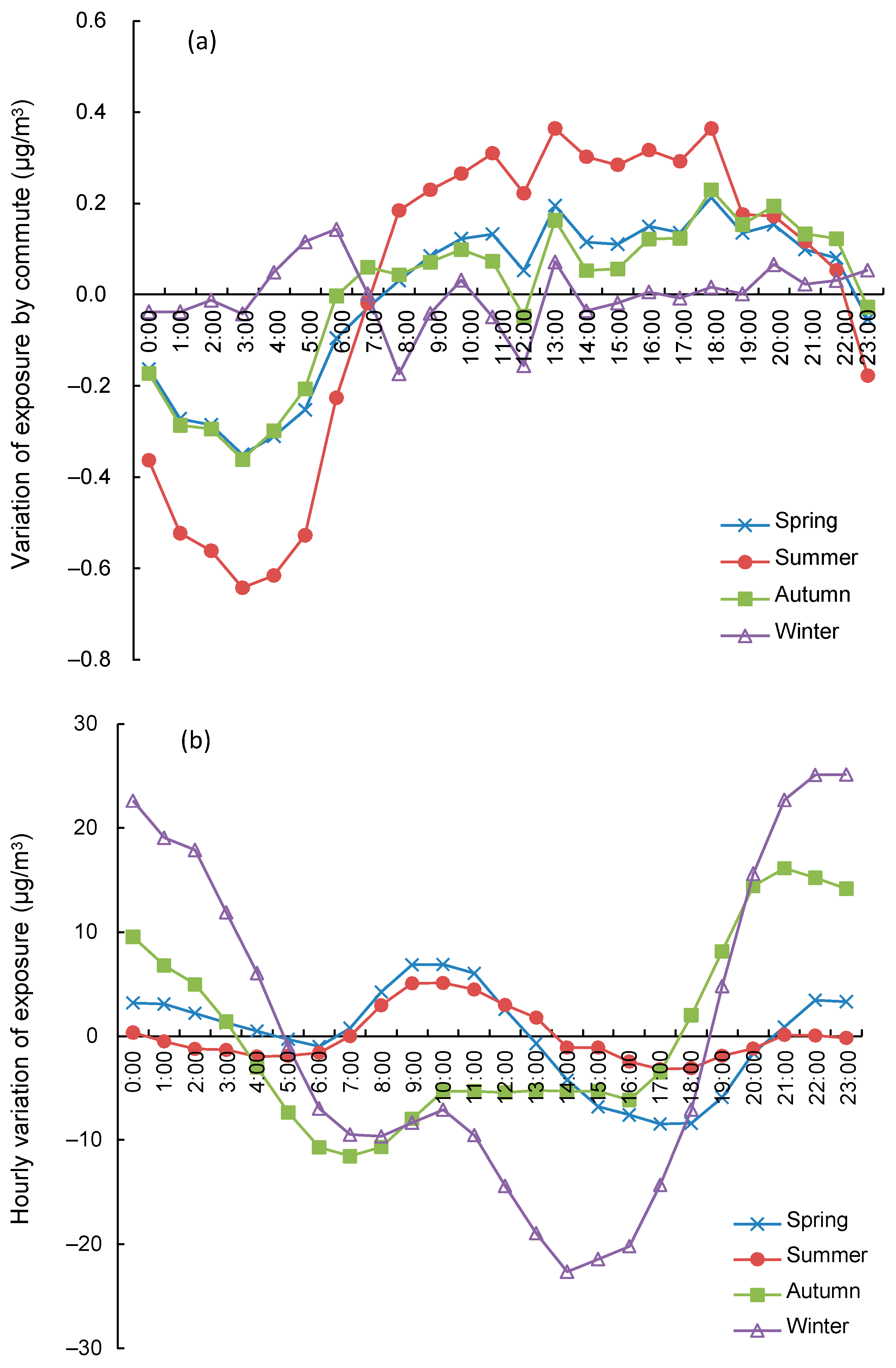Assessment of the Dynamic Exposure to PM2.5 Based on Hourly Cell Phone Location and Land Use Regression Model in Beijing
Abstract
:1. Introduction
2. Materials and Methods
2.1. Cellular Positioning
2.2. Study Area and Site Description
2.3. LUR Model for PM2.5 Predictions
2.4. Exposure Assessment
3. Results
3.1. Spatial Distribution of Base Stations and Average PM2.5
3.2. Commute of People
3.3. Diurnal Pattern of PM2.5
3.4. Exposure Assessment Based on the Active Population
3.5. Different Exposure Assessment Methods
4. Discussion
Author Contributions
Funding
Institutional Review Board Statement
Informed Consent Statement
Data Availability Statement
Acknowledgments
Conflicts of Interest
References
- Lippmann, M.; Lioy, P.J. Critical issues in air pollution epidemiology. Environ. Health Perspect. 1985, 62, 243–258. [Google Scholar] [CrossRef] [PubMed]
- Armstrong, B.G. Effect of measurement error on epidemiological studies of environmental and occupational exposures. Occup. Environ. Med. 1998, 55, 651. [Google Scholar] [CrossRef] [PubMed] [Green Version]
- Brokamp, C.; Rao, M.B.; Fan, Z.; Ryan, P.H. Does the elemental composition of indoor and outdoor PM2.5 accurately represent the elemental composition of personal PM2.5? Atmos. Environ. 2015, 101, 226–234. [Google Scholar] [CrossRef]
- Ragettli, M.S.; Corradi, E.; Braun-Fahrländer, C.; Schindler, C.; de Nazelle, A.; Jerrett, M.; Ducret-Stich, R.E.; Künzli, N.; Phuleria, H.C. Commuter exposure to ultrafine particles in different urban locations, transportation modes and routes. Atmos. Environ. 2013, 77, 376–384. [Google Scholar] [CrossRef]
- Li, R.K.; Li, Z.P.; Gao, W.J.; Ding, W.J.; Xu, Q.; Song, X.F. Diurnal, seasonal, and spatial variation of PM2.5 in Beijing. Sci. Bull. 2015, 60, 387–395. [Google Scholar] [CrossRef] [Green Version]
- Betts, K.S. Characterizing exposomes: Tools for measuring personal environmental exposures. Environ. Health Perspect. 2012, 120, A158–A163. [Google Scholar] [CrossRef] [Green Version]
- Dons, E.; Int Panis, L.; Van Poppel, M.; Theunis, J.; Willems, H.; Torfs, R.; Wets, G. Impact of time–activity patterns on personal exposure to black carbon. Atmos. Environ. 2011, 45, 3594–3602. [Google Scholar] [CrossRef]
- Yang, F.; Kaul, D.; Wong, K.C.; Westerdahl, D.; Sun, L.; Ho, K.-f.; Tian, L.; Brimblecombe, P.; Ning, Z. Heterogeneity of passenger exposure to air pollutants in public transport microenvironments. Atmos. Environ. 2015, 109, 42–51. [Google Scholar] [CrossRef] [Green Version]
- Spinazzè, A.; Cattaneo, A.; Scocca, D.R.; Bonzini, M.; Cavallo, D.M. Multi-metric measurement of personal exposure to ultrafine particles in selected urban microenvironments. Atmos. Environ. 2015, 110, 8–17. [Google Scholar] [CrossRef]
- Jerrett, M.; Donaire-Gonzalez, D.; Popoola, O.; Jones, R.; Cohen, R.C.; Almanza, E.; de Nazelle, A.; Mead, I.; Carrasco-Turigas, G.; Cole-Hunter, T.; et al. Validating novel air pollution sensors to improve exposure estimates for epidemiological analyses and citizen science. Environ. Res. 2017, 158, 286–294. [Google Scholar] [CrossRef]
- Karakatsani, A.; Samoli, E.; Rodopoulou, S.; Dimakopoulou, K.; Papakosta, D.; Spyratos, D.; Grivas, G.; Tasi, S.; Angelis, N.; Thirios, A.; et al. Weekly Personal Ozone Exposure and Respiratory Health in a Panel of Greek Schoolchildren. Environ. Health Perspect. 2017, 125, 077017. [Google Scholar] [CrossRef] [Green Version]
- Bekö, G.; Kjeldsen, B.U.; Olsen, Y.; Schipperijn, J.; Wierzbicka, A.; Karottki, D.G.; Toftum, J.; Loft, S.; Clausen, G. Contribution of various microenvironments to the daily personal exposure to ultrafine particles: Personal monitoring coupled with GPS tracking. Atmos. Environ. 2015, 110, 122–129. [Google Scholar] [CrossRef]
- Buonanno, G.; Stabile, L.; Morawska, L. Personal exposure to ultrafine particles: The influence of time-activity patterns. Sci. Total Environ. 2014, 468–469, 903–907. [Google Scholar] [CrossRef] [Green Version]
- Cao, J.; Yang, C.; Li, J.; Chen, R.; Chen, B.; Gu, D.; Kan, H. Association between long-term exposure to outdoor air pollution and mortality in China: A cohort study. J. Hazard. Mater. 2011, 186, 1594–1600. [Google Scholar] [CrossRef] [PubMed]
- Miller, K.A.; Siscovick, D.S.; Sheppard, L.; Shepherd, K.; Sullivan, J.H.; Anderson, G.L.; Kaufman, J.D. Long-term exposure to air pollution and incidence of cardiovascular events in women. N. Engl. J. Med. 2007, 356, 447–458. [Google Scholar] [CrossRef]
- van Rossem, L.; Rifas-Shiman, S.L.; Melly, S.J.; Kloog, I.; Luttmann-Gibson, H.; Zanobetti, A.; Coull, B.A.; Schwartz, J.D.; Mittleman, M.A.; Oken, E.; et al. Prenatal air pollution exposure and newborn blood pressure. Environ. Health Perspect. 2015, 123, 353–359. [Google Scholar] [CrossRef] [Green Version]
- Samet, J.M.; Dominici, F.; Curriero, F.C.; Coursac, I.; Zeger, S.L. Fine particulate air pollution and mortality in 20 US cities, 1987–1994. N. Engl. J. Med. 2000, 343, 1742–1749. [Google Scholar] [CrossRef] [PubMed]
- Pope III, C.A.; Ezzati, M.; Dockery, D.W. Fine-particulate air pollution and life expectancy in the United States. N. Engl. J. Med. 2009, 360, 376–386. [Google Scholar] [CrossRef] [Green Version]
- Yang, Y.; Cao, Y.; Li, W.; Li, R.; Wang, M.; Wu, Z.; Xu, Q. Multi-site time series analysis of acute effects of multiple air pollutants on respiratory mortality: A population-based study in Beijing, China. Sci. Total Environ. 2015, 508, 178–187. [Google Scholar] [CrossRef] [PubMed]
- Chen, L.; Shi, M.; Li, S.; Gao, S.; Zhang, H.; Sun, Y.; Mao, J.; Bai, Z.; Wang, Z.; Zhou, J. Quantifying public health benefits of environmental strategy of PM2.5 air quality management in Beijing–Tianjin–Hebei region, China. J. Environ. Sci. 2017, 57, 33–40. [Google Scholar] [CrossRef] [PubMed]
- Xu, A.; Xia, Y. The changes in mainland Chinese families during the social transition: A critical analysis. J. Comp. Fam. Stud. 2014, 45, 31–53. [Google Scholar] [CrossRef] [Green Version]
- Zandbergen, P.A. Accuracy of iPhone Locations: A Comparison of Assisted GPS, WiFi and Cellular Positioning. Trans. GIS 2009, 13, 5–25. [Google Scholar] [CrossRef]
- Deville, P.; Linard, C.; Martin, S.; Gilbert, M.; Stevens, F.; Gaughan, A.; Blondel, V.; Tatem, A. Dynamic population mapping using mobile phone data. Proc. Natl. Acad. Sci. USA 2014, 111, 15888–15893. [Google Scholar] [CrossRef] [PubMed] [Green Version]
- Liu, Z.; Ma, T.; Du, Y.; Pei, T.; Yi, J.; Peng, H. Mapping hourly dynamics of urban population using trajectories reconstructed from mobile phone records. Trans. GIS 2018, 22, 494–513. [Google Scholar] [CrossRef]
- Nyhan, M.; Grauwin, S.; Britter, R.; Misstear, B.; McNabola, A.; Laden, F.; Barrett, S.R.H.; Ratti, C. “Exposure Track”—The impact of mobile-device-based mobility patterns on quantifying population exposure to air pollution. Environ. Sci. Technol. 2016, 50, 9671–9681. [Google Scholar] [CrossRef] [Green Version]
- Briggs, D.J.; Collins, S.; Elliott, P.; Fischer, P.; Kingham, S.; Lebert, E.; Pryl, K.; Van Reeuwijk, H.; Small Bone, K.; Van Der Veen, A. Mapping urban air pollution using GIS: A regression-based approach. Int. J. Geogr. Inf. Sci. 1997, 11, 699–718. [Google Scholar] [CrossRef] [Green Version]
- Hoek, G.; Beelen, R.; de Hoogh, K.; Vienneau, D.; Gulliver, J.; Fischer, P.; Briggs, D. A review of land-use regression models to assess spatial variation of outdoor air pollution. Atmos. Environ. 2008, 42, 7561–7578. [Google Scholar] [CrossRef]
- Morley, D.W.; Gulliver, J. A land use regression variable generation, modelling and prediction tool for air pollution exposure assessment. Environ. Model. Softw. 2018, 105, 17–23. [Google Scholar] [CrossRef]
- Li, R.; Ma, T.; Xu, Q.; Song, X. Using MAIAC AOD to verify the PM2.5 spatial patterns of a land use regression model. Environ. Pollut. 2018, 243, 501–509. [Google Scholar] [CrossRef]
- Center for International Earth Science Information Network—CIESIN—Columbia University. Gridded Population of the World, Version 4 (GPWv4): Population Density; Revision 10; NASA Socioeconomic Data and Applications Center (SEDAC): Palisades, NY, USA, 2016. [Google Scholar] [CrossRef]
- Su, J.G.; Jerrett, M.; Beckerman, B. A distance-decay variable selection strategy for land use regression modeling of ambient air pollution exposures. Sci. Total Environ. 2009, 407, 3890–3898. [Google Scholar] [CrossRef]
- Su, J.G.; Jerrett, M.; Beckerman, B.; Wilhelm, M.; Ghosh, J.K.; Ritz, B. Predicting traffic-related air pollution in Los Angeles using a distance decay regression selection strategy. Environ. Res. 2009, 109, 657–670. [Google Scholar] [CrossRef] [PubMed] [Green Version]
- Dong, J.; Ma, R.; Cai, P.; Liu, P.; Yue, H.; Zhang, X.; Xu, Q.; Li, R.; Song, X. Effect of sample number and location on accuracy of land use regression model in NO2 prediction. Atmos. Environ. 2021, 246, 118057. [Google Scholar] [CrossRef]
- Chen, L.; Shi, M.; Li, S.; Bai, Z.; Wang, Z. Combined use of land use regression and BenMAP for estimating public health benefits of reducing PM2.5 in Tianjin, China. Atmos. Environ. 2017, 152, 16–23. [Google Scholar] [CrossRef]
- Hu, L.; Liu, J.; He, Z. Self-adaptive revised land use regression models for estimating PM2.5 concentrations in Beijing, China. Sustainability 2016, 8, 786. [Google Scholar] [CrossRef] [Green Version]
- Liu, C.; Henderson, B.H.; Wang, D.; Yang, X.; Peng, Z.-R. A land use regression application into assessing spatial variation of intra-urban fine particulate matter (PM2.5) and nitrogen dioxide (NO2) concentrations in City of Shanghai, China. Sci. Total Environ. 2016, 565, 607–615. [Google Scholar] [CrossRef] [PubMed]
- Meng, X.; Fu, Q.; Ma, Z.; Chen, L.; Zou, B.; Zhang, Y.; Xue, W.; Wang, J.; Wang, D.; Kan, H.; et al. Estimating ground-level PM10 in a Chinese city by combining satellite data, meteorological information and a land use regression model. Environ. Pollut. 2016, 208, 177–184. [Google Scholar] [CrossRef]
- Wu, J.; Li, J.; Peng, J.; Li, W.; Xu, G.; Dong, C. Applying land use regression model to estimate spatial variation of PM2.5 in Beijing, China. Environ. Sci. Pollut. Res. 2015, 22, 7045–7061. [Google Scholar] [CrossRef]
- WHO. WHO Air Quality Guidelines for Particulate Matter, Ozone, Nitrogen Dioxide and Sulfur Dioxide: Global Update 2005: Summary of Risk Assessment; WHO Press: Geneva, Switzerland, 2006; Available online: http://apps.who.int/iris/bitstream/10665/69477/1/WHO_SDE_PHE_OEH_06.02_eng.pdf (accessed on 20 March 2021).






| Prediction Function a | Adjusted R2 | CV R2 |
|---|---|---|
| Spring = 62.45 − 0.20 × DTS2190m − 22.96 × NDVI60m + 60.67 × YearlyAOD1500m | 0.86 | 0.83 |
| Summer = 70.30 − 0.22 × DTS4020m + 49.25 × Road5010m | 0.77 | 0.74 |
| Autumn = 115.71 − 0.50 × DTS1890m − 1.26 × Slope3840m | 0.85 | 0.84 |
| Winter = 22.90 + 323.41 × WinterAOD990m − 0.410 × DTS2370m | 0.89 | 0.86 |
| Average = 115.83 − 0.48 × DTS2400m − 1.15 × Slope4620m | 0.89 | 0.87 |
| Season | Mean (μg/m3) | Modeling (μg/m3) | Cross-Validation (μg/m3) | ||
|---|---|---|---|---|---|
| MAE | RMSE | MAE | RMSE | ||
| Spring | 80.60 | 2.52 | 3.15 | 2.84 | 3.55 |
| Summer | 67.03 | 2.87 | 3.63 | 3.13 | 3.97 |
| Autumn | 85.74 | 4.25 | 5.25 | 4.65 | 5.67 |
| Winter | 117.31 | 6.30 | 8.30 | 7.03 | 9.63 |
| Average | 87.42 | 3.37 | 4.33 | 3.72 | 4.75 |
| Ringed Road | Net increase during Daytime (Percent of Total Population) |
|---|---|
| 2nd | 2.9 |
| 3rd | 6.4 |
| 4th | 9.7 |
| 5th | 10.8 |
| Outside 5th | −10.8 |
| Exposure Method | Mean of the U.S. Embassy | Mean of the 35 Sites | Mean of the PM2.5 Map | Population Density-Weighted | Mobile Population-Weighted |
|---|---|---|---|---|---|
| Exposed PM2.5 (μg/m3) | 93.5 | 87.2 | 68.3 | 87.9 | 89.5 |
Publisher’s Note: MDPI stays neutral with regard to jurisdictional claims in published maps and institutional affiliations. |
© 2021 by the authors. Licensee MDPI, Basel, Switzerland. This article is an open access article distributed under the terms and conditions of the Creative Commons Attribution (CC BY) license (https://creativecommons.org/licenses/by/4.0/).
Share and Cite
Liu, J.; Cai, P.; Dong, J.; Wang, J.; Li, R.; Song, X. Assessment of the Dynamic Exposure to PM2.5 Based on Hourly Cell Phone Location and Land Use Regression Model in Beijing. Int. J. Environ. Res. Public Health 2021, 18, 5884. https://doi.org/10.3390/ijerph18115884
Liu J, Cai P, Dong J, Wang J, Li R, Song X. Assessment of the Dynamic Exposure to PM2.5 Based on Hourly Cell Phone Location and Land Use Regression Model in Beijing. International Journal of Environmental Research and Public Health. 2021; 18(11):5884. https://doi.org/10.3390/ijerph18115884
Chicago/Turabian StyleLiu, Junli, Panli Cai, Jin Dong, Junshun Wang, Runkui Li, and Xianfeng Song. 2021. "Assessment of the Dynamic Exposure to PM2.5 Based on Hourly Cell Phone Location and Land Use Regression Model in Beijing" International Journal of Environmental Research and Public Health 18, no. 11: 5884. https://doi.org/10.3390/ijerph18115884
APA StyleLiu, J., Cai, P., Dong, J., Wang, J., Li, R., & Song, X. (2021). Assessment of the Dynamic Exposure to PM2.5 Based on Hourly Cell Phone Location and Land Use Regression Model in Beijing. International Journal of Environmental Research and Public Health, 18(11), 5884. https://doi.org/10.3390/ijerph18115884







